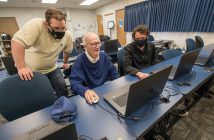While the capstone experience has always been required of environmental science majors, it has been retooled this past year by Tim Parshall, Ph.D., to have greater significance and impact.
In the past, the capstone project could have been an internship, an independent research project or the senior seminar. In the fall of 2013, Marsha Marotta, Ph.D., Vice President of Academic Affairs, secured a $148,000 state grant from the Department of Higher Education for the rapid expansion of civic engagement efforts on campus.
This civic engagement movement (see related stories, Page 20 and 21) is designed to not just send University students out into the community to do good work, but to have students work hand in hand with regional and global community members, and to help those members identify what their needs are and attempt to find the means to meet them.
By linking the senior seminar with the civic engagement courses, Dr. Parshall was able to pair students with community partners on environmental research projects, creating a win-win scenario.
Students receive the opportunity to immerse themselves in research projects focused on actual community needs, allowing them to gain relevant field experience.
“Our students have spent three and a half years in the classroom learning their trade. This last-semester capstone project gives them a chance to test drive their knowledge and skills, working with a community partner,” says Dr. Parshall. “This is the top senior experience for our students. It builds on the total experience, and it offers a more substantial experience than a traditional course.”
Members of the community who mentor students get the chance to gather data and conduct research that might not otherwise be undertaken.
“Our students are partnered with community members like the Department of Environmental Protection (DEP), Nature Conservancy or Mass Fish and Wildlife,” says Michael Vorwerk, Ph.D., Chair of the Environmental Science Department. “They perform real-world research, work that needs to be done, that organizations like DEP might not have the workforce to perform.”
This past semester, students worked in groups of four to five members on one of these three research projects:
Mapping Wildlife Corridors in the Westfield River Watershed
Under the mentorship of Dr. Laura Marx of the Nature Conservancy, students used wildlife cameras and GPS technology to map direct observations of roadkill to determine wildlife corridors within the watershed.
Investigating Eradication Methods for Invasive Species
Under the mentorship of Julie Richburg of the Trustees of Reservation and Westfield River Invasive Species Partnership, students identified, marked and mapped plots of oriental bittersweet in the University wildlands and then carried out initial manual eradication.
Tracking Point Source Pollution in the Westfield River by Sampling E. coli
Under the mentorship of Cindy Delpapa and Carrie Banks of the Massachusetts Fish and Wildlife Division of Ecological Restoration, students took water samples, tested them for fecal coliform (bacteria found in animal waste) and then tracked pollution hotspots upstream to find their sources.
Because the research conducted in these capstone projects has practical importance within the community, these projects do not have to end when the seniors have graduated.
“The data collection period is long term and takes place over many years,” says Dr. Parshall. “The great aspect of this is that new students can pick up where the last group left off. They can build on the data that has already been collected and not have to start all over.”
Dr. Vorwerk says reporting the data is also a critical experience for students.
“Our students attend the Bridgewater State University Undergraduate Environmental Science Research Symposium in the fall, and the UMass Undergraduate Research Conference in the spring,” he says. “There they share their projects and findings with other researchers.”




